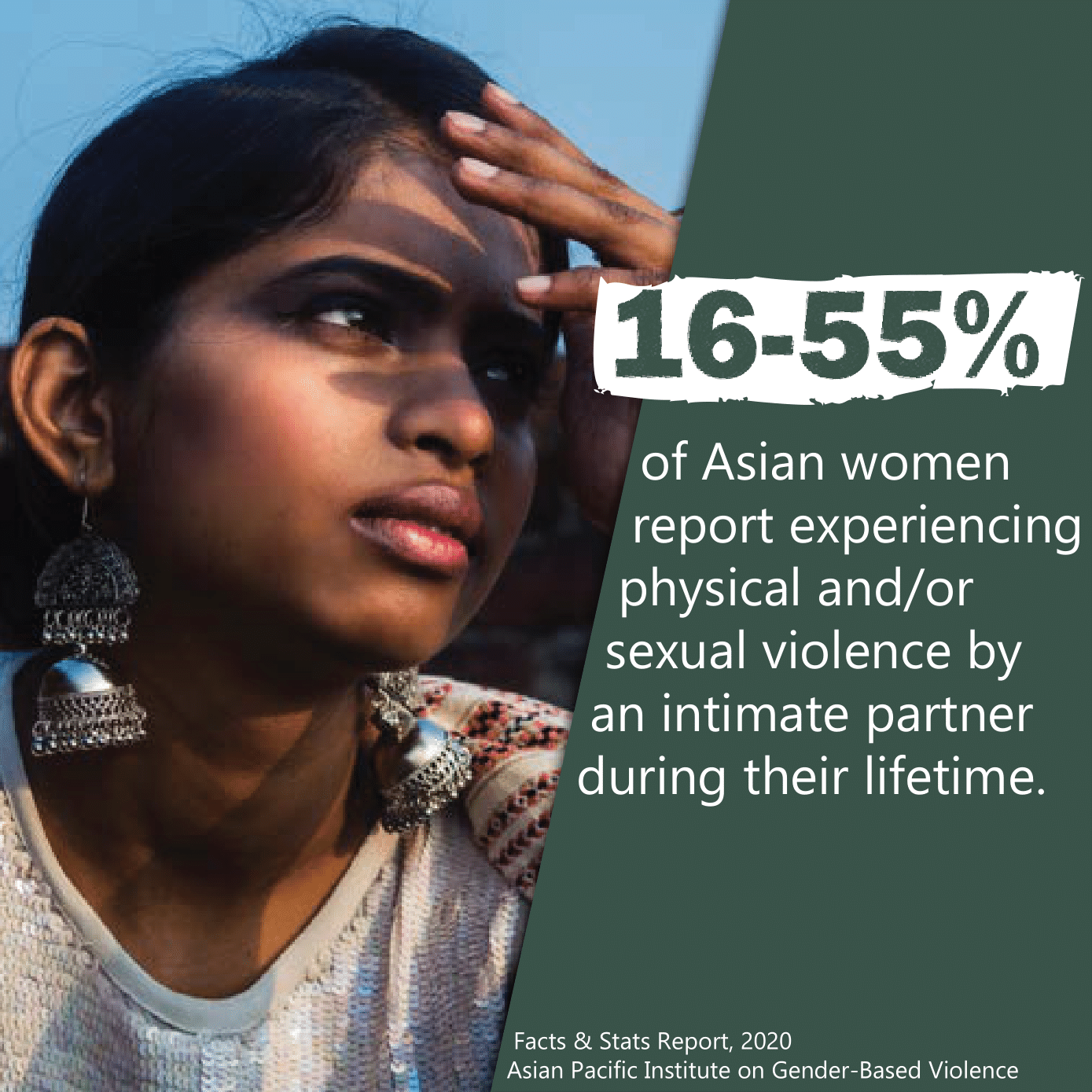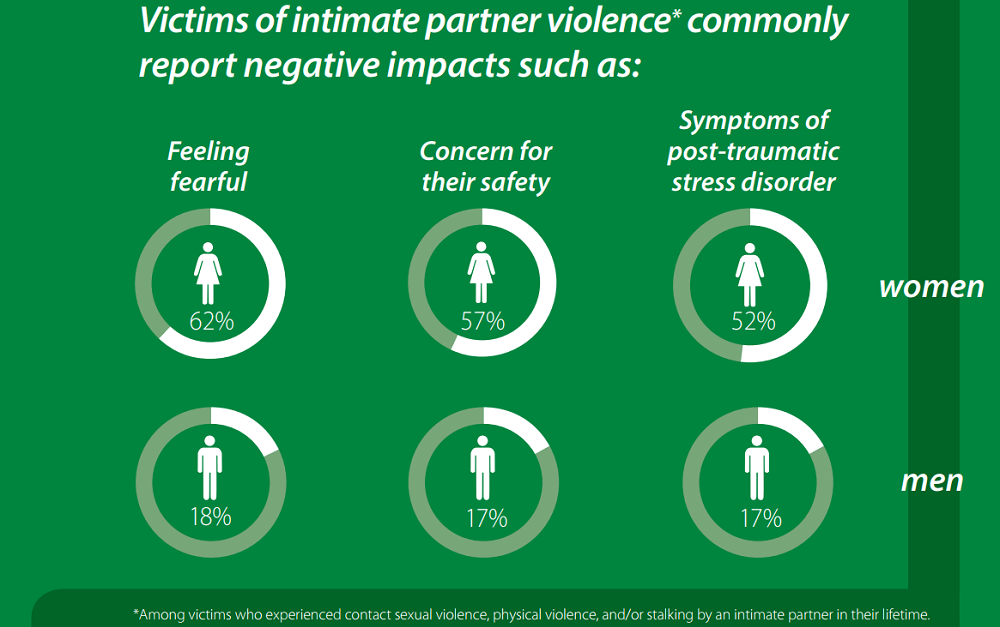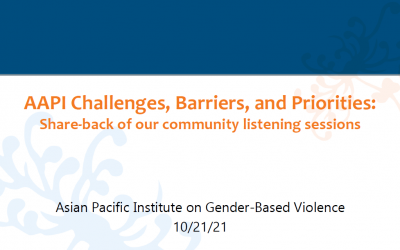Domestic Violence
Definition
Domestic violence is a systematic pattern of behaviors that include physical battering, coercive control, economic abuse, emotional abuse, and/or sexual violence. It is intended to gain or maintain power and control over a romantic or intimate partner to intimidate, frighten, terrorize, humiliate, blame, or injure. It can happen to anyone of any age, race, sexual orientation, gender identity, gender, religion, education level, or socioeconomic background; regardless of whether couples are married, living together, dating, or hooking-up.
Ethnic-Specific Factsheets on Domestic Violence
Ethnic-specific compilations of statistics on domestic violence, sexual violence, stalking, and help-seeking in Asian communities in the U.S.
Quick Facts
- Studies from different countries show that 15-71% of women 15-49 years old have experienced physical and/or sexual violence by an intimate partner in their lifetime.
WHO: Violence against Women: The Health Sector Responds (2013) - Among ever-partnered men, 26-80% have perpetrated physical and/or sexual partner violence in their lifetime.
WHO: Violence against Women: The Health Sector Responds (2013) - In a six-year period, 160 cases of domestic violence related homicide resulted in 226 fatalities, of which 78% of victims were women and girls.
Shattered Lives: Homicides, Domestic Violence, and Asian Families (2010) - 56% of Filipinas and 64% of Indian or Pakistani battered women report intimate sexual violence.
- 68% of Filipinas and 50% of Indian or Pakistani battered women report being stalked by an intimate partner.
Intimate Partner Violence and Help-Seeking (2011)
Analysis
Stress and marginalized identities are not the cause or explanation for domestic violence. Women have the same life experiences and stresses: they come from violent homes, they have childhood histories of abuse, neglect or abandonment, they get cut off on the freeway, they get high or drunk, they get fired from their jobs, they juggle economic hardships, etc. Women are socialized in cultures with legacies of colonialism, live in war zones, endure racism, deal with new cultures as immigrants and face societal and linguistic barriers. And yet, women by and large do not resort to physical abuse. Non-abusive men are also subject to the same stressors. Women and non-abusive men do of course have personal and inter-personal difficulties, psychological problems, feel depressed, lack parenting insights, have inadequate job skills, are constrained by poverty, but cope without resorting to violence. Finally, men who do not have any of these difficulties or deficits, batter. It is important therefore, to de-link external factors as the root causes of domestic violence.
Two Significant, Differing Dynamics In Asian Homes
Domestic violence is a universal problem, but its cultural expressions differ. Drawing attention to such differences can serve to confirm stereotypes because nuanced complexities are hard to convey; but advocacy that is not rooted in cultural contexts is even more problematic.
Multiple Batterers, Single Victim
- Perpetrators can include marital family members: husbands, mothers-in-law, fathers-in-law, brothers-in-law, sisters-in-law, ex-wives, new wives; and/or members of a woman’s natal family – her parents, aunts, uncles, adult siblings.
- Multiple batterers may act separately, each using different types of abuse.
- Multiple batterers can act together, playing different roles in one incident.
- In-laws may encourage or support domestic violence, but not perpetrate it themselves.
- Multiple abusers may use coercive control tactics; exercise micro-controls on daily movements – monitoring, tracking, and reporting on them; exert power and control from afar through texting, webcams, other technologies.
Push & Pull Factors
- Pull factors are behaviors and statements that ‘pull’ or lure her back into the relationship by offering apologies, reassurances and promises to change.
- Push factors are meant to ‘push’ her out of the relationship, rather than draw her back in.
- Asian women report feeling pushed out of the relationship or marital home (with statements such as “leave the house, give me a divorce, I can always find another wife”) more frequently than they are pulled or enticed back into it.
- Push and pull factors affect how survivors make decisions, especially about leaving.
Resources on Domestic Violence
Defending Criminalized Survivors Workshop
What happens when the laws that are supposed to protect survivors of domestic violence and sexual assault become turned against them? Survivors can be criminalized for reacting in self-defense, participating in criminal activity under their abusers’ coercion, or for failing to protect their children from witnessing or being impacted by violence in the home. Survivors of color, who struggle with mental health or substance dependency, or who otherwise don’t fold the “perfect victim” mold are disproportionately incarcerated. In this workshop, API-GBV will be joined by Hyejin Shim and Neda Said of Survived & Punished, who will guide participants through a discussion of the criminalization of survivors, and how advocates can support criminalized survivors.
Making Our Home and Community Safe: Responding to Afghan Evacuees
Following the sudden withdrawal of U.S. military presence from Afghanistan nearly 100,000 Afghan refugees were evacuated to the United States, with many still remaining on U.S. military bases and resettlement to happen by the end of January 2022. Many evacuees now face uncertainty related to their immigration status, concern about families back in Afghanistan, and the challenge of acclimating to life in the U.S.
AAPI Challenges, Barriers, and Priorities: Share-back of our community listening sessions
Over the past year and a half, API-GBV strove to learn more deeply from our community of front-line advocates, national partners, systems contacts, and allies through a series of listening sessions, assessment, and surveys. During this webinar, staff shared themes and...
Relationship Violence in Five Los Angeles Asian American Communities: Intergenerational Risk and Strengthening Factors
This study explores risk and protective factors in five Asian American communities: Cambodian, Chinese, Korean, North Indian Hindu, and Pakistani Muslim. These factors include cultural traditions, norms, attitudes and beliefs, particularly around gender roles, intergenerational family dynamics, intimate relationships, and approaches to child-rearing. This study involved 23 semi-structured focus groups (163 total participants) to gather the perspectives of youth/young adults, parents, community leaders, and service providers in six different languages across the five communities.
How COVID-19 and Systemic Responses Are Impacting Asian and Pacific Islander Survivors of Domestic Violence and Sexual Assault
This advisory explains how the COVID-19 outbreak is impacting Asian and Pacific Islander (API) survivors of domestic violence and sexual assault, and describes policies enacted to address the pandemic including the CARES Act, and API and immigrant survivors’ eligibility for the programs and services offered in the legislation, as well as the implications of utilizing the services. The Advisory also discusses the effect of systematic responses to the COVID-19 crisis and the unique issues that API survivors face that systems must account for to support survivor safety during the pandemic.
Facts & Stats Report: Domestic Violence in Asian and Pacific Islander Homes, 2020
Statistics from published and unpublished studies on prevalence of abuse, domestic violence, types of abuse, attitudes towards domestic violence, help seeking attitudes and experiences, service utilization, health and mental health consequences, exposure to family violence in childhood, and domestic violence related homicides.
Factsheet: Domestic Violence, Sexual Violence, and Human Trafficking in Native Hawaiian Communities, 2020
Statistics, and information on domestic violence, and human trafficking in Native Hawaiian communities
Domestic Violence Hotlines
National Domestic Violence Hotline
1-800-799-SAFE (7233) or online chat
Love Is Respect
1-866-331-8453 | Text ‘loveis’ to 22522
or online chat
StrongHearts Native Helpline
1-844-762-8483
Technical Assistance & Training from the Domestic Violence Resource Network (DVRN)
Asian Pacific Institute on Gender-Based Violence
Battered Women’s Justice Project: civil, criminal and military justice systems.
Capacity Building and Program Technical Assistance for FVPSA Formula Grantees: a project of the National Network to End Domestic Violence
Capacity Center to Expand Services to Children, Youth, and Abused Parents: a project of Futures Without Violence
National Center on Domestic Violence, Trauma and Mental Health
National Clearinghouse for the Defense of Battered Women
National Council of Juvenile and Family Court Judges
National Health Resource Center on Domestic Violence: a project of Futures Without Violence
National Indigenous Women’s Resource Center
National Latin@ Network for Healthy Families and Communities: a project of Casa de Esperanza
National LGBTQ Institute on IPV: a project of the Northwest Network of Bi, Trans, Lesbian and Gay Survivors
National Resource Center on Domestic Violence: The most comprehensive resource on domestic violence, including VAWnet’s special collections on a wide range of topics
Ujima, Inc.: The National Center on Violence Against Women in the Black Community
Curriculum: Domestic Violence Against Asian & Pacific Islander Women
This training curriculum on serving API domestic violence survivors addresses dynamics such as violence over the lifecourse and multiple batterers.







